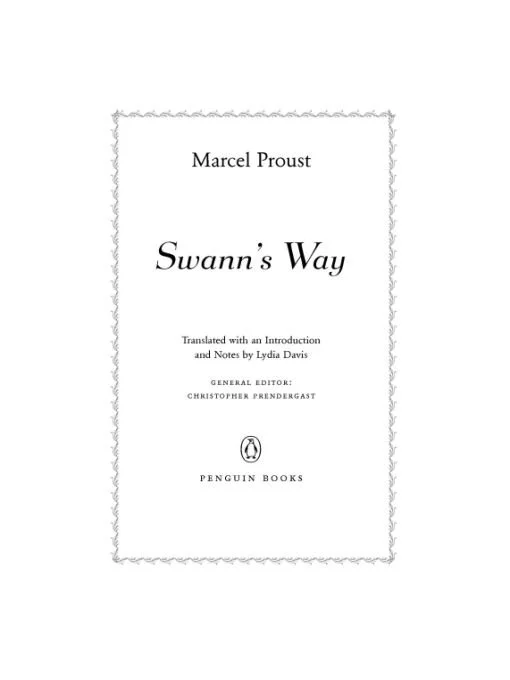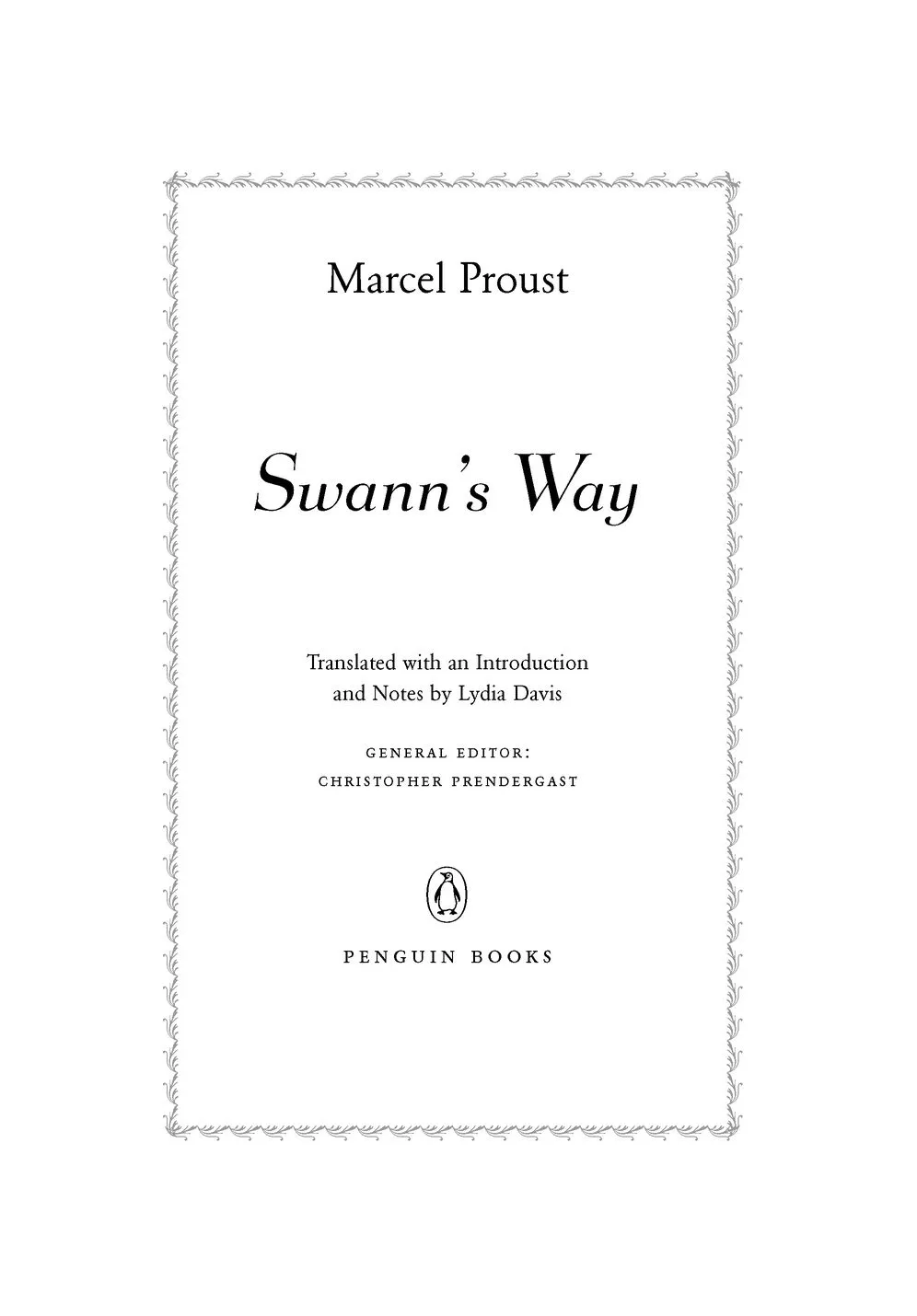Swann's Way

Table of Contents
Title Page
Copyright Page
Introduction
PART I - Combray
Chapter 1
Chapter 2
PART II - Swann in Love
PART III - Place-Names: The Name
Notes
Synopsis
SWANN’S WAY
MARCEL PROUST was born in Auteuil in 1871. In his twenties, following a year in the army, he became a conspicuous society figure, frequenting the most fashionable Paris salons of the day. After 1899, however, his chronic asthma, the death of his parents, and his growing disillusionment with humanity caused him to lead an increasingly retired life. From 1907 on, he rarely emerged from a cork-lined room in his apartment on boulevard Haussmann. There he insulated himself against the distractions of city life and the effects of trees and flowers—though he loved them, they brought on his attacks of asthma. He slept by day and worked by night, writing letters and devoting himself to the completion of In Search of Lost Time. He died in 1922.
LYDIA DAVIS, a 2003 MacArthur Fellow, is the author of a novel, The End of the Story, and three volumes of short fiction, the latest of which is Samuel Johnson Is Indignant. She is also the translator of numerous works by Maurice Blanchot, Michel Leiris, Pierre Jean Jouve, and many others and was recently named a Chevalier of the Order of Arts and Letters by the French government. Her essay on close translation of Proust appeared in the April 2004 issue of the Yale Review.
To access Great Books Foundation Discussion Guides online, visit our Web site at www.penguin.com or the Foundation Web site at www.greatbooks.com

BookishMall.com
Published by the Penguin Group
Penguin Group (USA) Inc., 375 Hudson Street, New York, New York 10014, U.S.A.
Penguin Group (Canada), 90 Eglinton Avenue East, Suite 700, Toronto, Ontario,
Canada M4P 2Y3 (a division of Pearson Penguin Canada Inc.)
Penguin Books Ltd, 80 Strand, London WC2R 0RL, England
Penguin Ireland, 25 St Stephen’s Green, Dublin 2, Ireland
(a division of Penguin Books Ltd)
Penguin Group (Australia), 250 Camberwell Road, Camberwell, Victoria 3124,
Australia (a division of Pearson Australia Group Pty Ltd)
Penguin Books India Pvt Ltd, 11 Community Centre, Panchsheel Park,
New Delhi - 110 017, India
Penguin Group (NZ), 67 Apollo Drive, Rosedale, North Shore,
Auckland 0745, New Zealand (a division of Pearson New Zealand Ltd)
Penguin Books (South Africa) (Pty) Ltd, 24 Sturdee Avenue, Rosebank,
Johannesburg 2196, South Africa
Penguin Books Ltd, Registered Offices: 80 Strand, London WC2R 0RL, England
First published in the United States of America by Viking Penguin, a member of Penguin Group (USA) Inc. 2003 Published in Penguin Books 2000, 2004
Translation, introduction, and notes copyright © Lydia Davis, 2002
All rights reserved
Proust, Marcel, 1871-1922
[Du côté de chez Swann. English]
Swann’s way / Marcel Proust ; translated with an introduction and notes by Lydia Davis ; general editor, Christopher Prendergast. p. cm.
eISBN : 978-1-101-50126-9
I. Davis, Lydia. II Prendergast, Christopher. III. Title.
PQ2631.R63D813 2003
843’.912-dc21 2003049743
The scanning, uploading and distribution of this book via the Internet or via any other means without the permission of the publisher is illegal and punishable by law. Please purchase only authorized electronic editions, and do not participate in or encourage electronic piracy of copyrighted materials. Your support of the author’s rights is appreciated.
http://us.penguingroup.com
Introduction
Many passages from Marcel Proust’s Swann’s Way are by now so well known that they have turned into clichés and reference points and occupy a permanent place in contemporary Western culture. Scenes and episodes are familiar even to many who have not actually read the book: say “Proust” and they will immediately think “madeleine” and “tea,” if not “cork-lined room.” Yet confronting the book itself is an entirely different, and individual, experience. One will have one’s own way of visualizing the narrator’s childhood bedtime scene with his mother, his visits to his hypochondriac aunt, his teasing of the servant Françoise, his embrace of the prickly hawthorns, his vision of the three steeples, and his first piece of serious writing. Swann’s agonizing love affair with Odette and the narrator’s youthful infatuation with Swann’s daughter Gilberte will be colored by the personal associations of each reader, who will likewise have unexpected memories, recalled by unexpected stimuli, that will enable him or her to identify with the narrator in the most famous scene of all, in which the taste of a tea-soaked madeleine suddenly incites his full recollection of his childhood in the village of Combray and, from this, leads to the unfolding of all the subsequent action in the three-thousand-page novel.
One will find, too, that the better acquainted one becomes with this book, the more it yields. Given its richness and resilience, Proust’s work may be, and has been, enjoyed on every level and in every form—as quotation, as excerpt, as compendium, even as movie and comic book—but in the end it is best experienced, for most, in the way it was meant to be, in the full, slow reading and rereading of every word, in complete submission to Proust’s subtle psychological analyses, his precise portraits, his compassionate humor, his richly colored and lyrical landscapes, his extended digressions, his architectonic sentences, his symphonic structures, his perfect formal designs.
Swann’s Way is divided into three parts: “Combray,” “Swann in Love,” and “Place-Names: The Name.” “Combray,” itself divided into two parts, opens with the bedtime of the narrator as a grown man: he describes how he used to spend the sleepless portions of his nights remembering events from earlier in his life and finally describes the episode of the madeleine. A second and much longer section of “Combray” follows, containing the memories of his childhood at Combray that were summoned by the taste of the “petite madeleine” and that came flooding back to him in unprecedentedly minute and sensuous detail. This first part of the book, having opened at bedtime, closes—itself like a long sleepless night—at dawn.
“Swann in Love,” which jumps back in time to a period before the narrator was born, consists of the self-contained story of Swann’s miserable, jealousy-racked love for the shallow and fickle Odette, who will one day be his wife; the narrator with whom we began the book scarcely appears at all.
The third and last part, “Place-Names: The Name,” much shorter than the rest of the volume, includes the story of the narrator’s infatuation, as a boy, with Swann’s daughter Gilberte during the weeks they play together on the chilly lawns of the Champs-Élysées and ends with a sort of coda which jumps forward in time: on a late November day, at the time of the writing, the narrator, walking through the Bois de Boulogne, muses on the contrast between the beauties of the days of his childhood and the banality of the present, and on the nature of time.
The story is told in the first person. Proust scholars have identified a handful of slightly different I’s in the novel as a whole, but the two main I’s are those of the rather weary, middle-aged narrator as he tells the story and the narrator as a child and young man. The first person, however, is abandoned for shorter or longer intervals in favor of what is in effect an omniscient narrator, as when, in “Combray,” we witness conversations between his aunt Léonie and the servant Françoise which the boy could not have heard; and most remarkably during nearly the whole of “Swann in Love.”
The story is told in the first person, the protagonist is referred to several times in the course of In Search of Lost Time, though not in Swann’s Way, as “Marcel,” and the book is filled with events and characters closely resembling those of Proust’s own life, yet this novel is not autobiography wearing a thin disguise of fiction but, rather, something more complex—fiction created out of real life, based on the experiences and beliefs of its author, and presented in the guise of autobiography. For although Proust’s own life experience is the material from which he forms his novel, this material has been altered, recombined, shaped to create a coherent and meaningful fictional artifact, a crucial alchemy—art’s transformation of life—which is itself one of Proust’s preoccupations and a principal subject and theme of the book.
The episode of the madeleine, for instance, was based on an experience of Proust’s own, but what Proust apparently dipped in his tea was a rusk of dry toast, and the memory that then returned to him was his morning visits to his grandfather.
1 comment